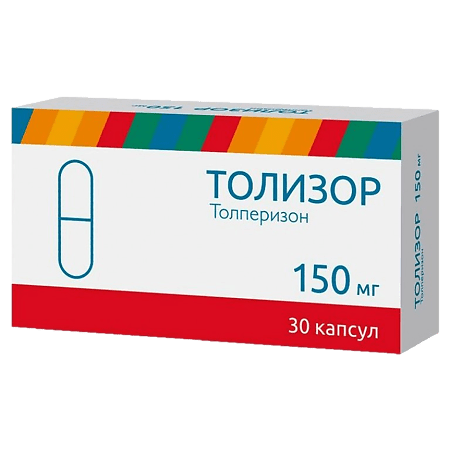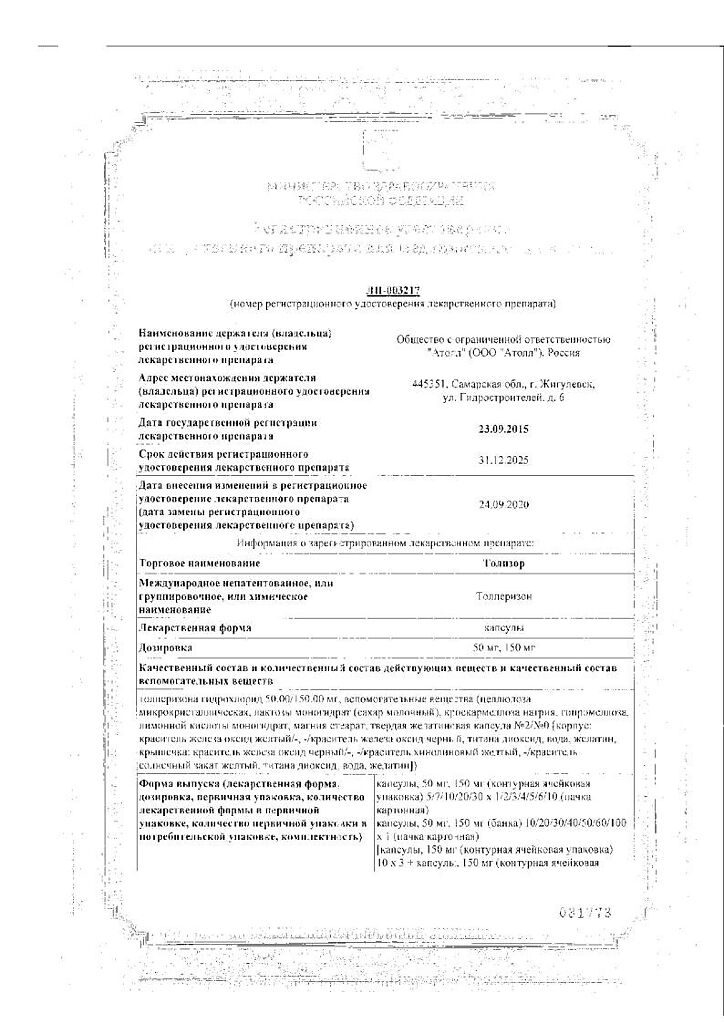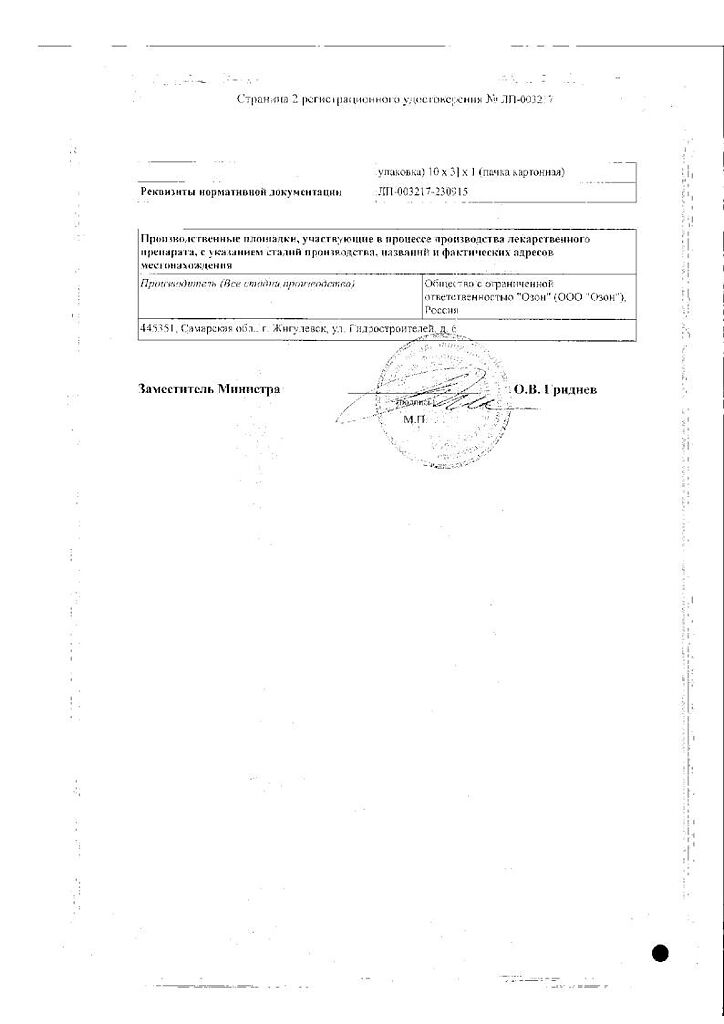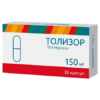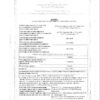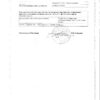No products in the cart.
Tolizor, 150 mg capsules 30 pcs
€11.40 €9.50
Description
Tolperizone is a myorelaxant of central action. The mechanism of action is not fully elucidated. Tolperizone has high affinity to the nervous tissue, reaching the highest concentrations in the brain stem, spinal cord and peripheral nervous system.
The main effect of tolperizone is mediated by inhibition of spinal reflex arcs. This effect, together with the elimination of the facilitation of excitation conduction along the descending pathways, probably provides the therapeutic effect of tolperisone. The chemical structure of tolperizone is similar to that of lidocaine.
Like lidocaine, it has a membrane stabilizing effect and reduces electrical excitability of motor neurons and primary afferent fibers.
Tolperizone dose-dependently inhibits the activity of potential-dependent sodium channels.
Accordingly, the amplitude and frequency of action potential is reduced. A suppressive effect on potential-dependent calcium channels has been proven. It is assumed that in addition to its membrane-stabilizing effect, tolperizone may also inhibit mediator release. Tolperizone has some weak a-adrenergic antagonist properties and antimuscarinic action.
Indications
Indications
Symptomatic treatment of spasticity in adults due to stroke.
Pharmacological effect
Pharmacological effect
Tolperisone is a centrally acting muscle relaxant. The mechanism of action is not fully understood. Tolperisone has a high affinity for nervous tissue, reaching the highest concentrations in the brain stem, spinal cord and peripheral nervous system.
The main effect of tolperisone is mediated by inhibition of spinal reflex arcs. Probably, this effect, together with the elimination of the facilitation of excitation along descending pathways, provides the therapeutic effect of tolperisone. The chemical structure of tolperisone is similar to the structure of lidocaine.
Like lidocaine, it has a membrane-stabilizing effect and reduces the electrical excitability of motor neurons and primary afferent fibers.
Tolperisone dose-dependently inhibits the activity of voltage-gated sodium channels.
Accordingly, the amplitude and frequency of the action potential decreases. An inhibitory effect on voltage-gated calcium channels has been proven. It is assumed that in addition to its membrane-stabilizing effect, tolperisone may also inhibit transmitter release. Tolperisone has some weak α-adrenergic antagonist and antimuscarinic properties.
Special instructions
Special instructions
The most common adverse reactions are hypersensitivity reactions. Allergic reactions range from mild skin to severe systemic, including anaphylactic shock.
Symptoms of an allergic reaction: redness, rash, urticaria, itching, angioedema (Quincke’s edema), tachycardia, hypotension and shortness of breath.
Female patients with a history of hypersensitivity reactions to other drugs or allergic reactions are at higher risk.
In cases of known hypersensitivity to lidocaine, increased caution should be exercised when using tolperisone due to possible cross-reactions.
Patients should be alert for any symptoms of hypersensitivity.
If symptoms occur, you should immediately stop taking tolperisone and consult a doctor immediately. Tolperisone should not be re-prescribed after an episode of hypersensitivity to a drug containing it.
The effect of the drug on the ability to drive vehicles and machinery
Tolisor does not affect the ability to drive vehicles and machinery. Patients who experience dizziness, drowsiness, impaired attention, convulsions, blurred vision or muscle weakness while taking the drug should consult a doctor!
Active ingredient
Active ingredient
Tolperisone
Composition
Composition
active substance:
tolperisone hydrochloride -150.00 mg;
excipients:
microcrystalline cellulose – 70.00 mg;
lactose monohydrate (milk sugar) – 43.50 mg;
croscarmellose sodium -12.00 mg;
hypromellose – 3.00 mg;
citric acid monohydrate – 4.50 mg;
magnesium stearate -2.00 mg.
composition of the capsule body: black iron oxide dye – 0.0500%; titanium dioxide – 2.0000%; water -14.50%; gelatin – up to 100%.
composition of the capsule cap: quinoline yellow dye – 0.7500%; sunset yellow dye – 0.0059%; titanium dioxide – 2.0000%; water -14.50%; gelatin – up to 100%.
Contraindications
Contraindications
Hypersensitivity to any of the components of the drug.
Myasthenia gravis.
Children under 18 years of age.
Breastfeeding.
Lactose intolerance, lactase deficiency, glucose-galactose malabsorption.
Side Effects
Side Effects
The safety profile of tolperisone drugs is confirmed by data from use in more than 12,000 patients. According to these data, the most frequently described disorders are skin and subcutaneous tissue disorders, general, neurological and gastrointestinal disorders.
During the post-registration period, the number of reports received about the development of hypersensitivity reactions associated with the use of tolperisone was about 50-60% of all reports received. In most cases these were non-serious adverse reactions. Life-threatening allergic reactions have been reported very rarely.
The incidence of adverse reactions is classified according to the recommendations of the World Health Organization, characterized as: very often (>1/10), often (>1/100, 1/1000, 1/10000, <1/1000), very rarely (<1/10000), including isolated cases, the frequency is unknown (cannot be calculated based on the available data).From the blood and lymphatic system: very rarely – anemia, lymphadenopathy.From the immune system: rarely – hypersensitivity reactions*, anaphylactic reactions; very rarely – anaphylactic shock.From the side of metabolism and nutrition: infrequently – anorexia; very rarely – polydipsia.From the mental side: infrequently – sleep disturbance, insomnia; rarely – weakness, depression; very rarely – confusion.From the nervous system: infrequently – headache, dizziness, drowsiness; rarely – attention deficit disorder, tremor, convulsions, paresthesia, malaise, lethargy.From the organ of vision: rarely – decreased visual acuity.From the organ of hearing: rarely – tinnitus, vertigo.From the cardiovascular system: infrequently – arterial hypotension; rarely – angina pectoris, tachycardia, palpitations, flushing of blood to the face; very rarely – bradycardia.From the respiratory system: rarely – shortness of breath, nosebleeds, tachypnea.From the gastrointestinal tract: uncommon – abdominal discomfort, dyspepsia, diarrhea, dry mouth, nausea; rarely – epigastric pain, constipation, flatulence, vomiting.From the liver and biliary tract: rarely – moderate liver failure.From the skin and subcutaneous tissues: rarely – allergic dermatitis, hyperhidrosis, itching, skin rash, urticaria.From the musculoskeletal system and connective tissue: infrequently – muscle pain, muscle weakness, pain in the extremities; rarely – discomfort in the limbs; very rarely – osteopenia.From the kidneys and urinary tract: rarely – enuresis, proteinuria.General disorders and reactions at the injection site: infrequently – asthenia, fatigue, malaise; rarely – a feeling of intoxication, a feeling of warmth, irritability, thirst; very rarely – discomfort in the chest.Laboratory indicators: rarely – hyperbilirubinemia, liver dysfunction, thrombocytopenia, leukocytosis; very rarely – hypercreatininemia.*Angioedema, including swelling of the face and lips, has been reported during post-marketing monitoring (frequency unknown).
Interaction
Interaction
Studies of pharmacokinetic drug interactions with the marker substrate of the CYP2D6 isoenzyme dextromethorphan have shown that the simultaneous use of tolperisone can increase the blood levels of drugs that are metabolized primarily by the CYP2D6 isoenzyme (thioridazone, tolterodine, venlafaxine, atomoxetine, desipramine, dextromethorphan, metoprolol, nebivolol, perphenazine).
In laboratory experiments on human liver microsomes and human hepatocytes, no significant inhibition or induction of other CYP isoenzymes (CYP2B6, CYP2C8, CYP2C9, CYP2C19, CYP1A2, CYP3A4) was detected. Due to the variety of metabolic pathways of tolperisone, increased exposure to tolperisone with simultaneous use of isoenzyme substrates
CYP2D6 and/or other drugs are not expected.
The bioavailability of tolperisone decreases when taken on an empty stomach.
Despite the fact that Tolperisone is a centrally acting drug, its sedative effect is very low. When used simultaneously with other centrally acting muscle relaxants, the dose of tolperisone should be reduced. Tolperisone enhances the effect of niflumic acid, therefore, with simultaneous use, a reduction in the dose of niflumic acid or other nonsteroidal anti-inflammatory drugs (NSAIDs) should be considered.
Overdose
Overdose
Data on tolperisone overdose are scarce.
In preclinical acute toxicity studies, high doses of tolperisone caused ataxia, tonic-clonic seizures, dyspnea, and respiratory paralysis.
Tolperisone does not have a specific antidote.
In case of overdose, symptomatic and supportive treatment is recommended.
Storage conditions
Storage conditions
In a place protected from light at a temperature not exceeding 25°C.
Keep out of the reach of children.
Shelf life
Shelf life
3 years.
Do not use after the expiration date stated on the package.
Manufacturer
Manufacturer
Ozon, Russia
Additional information
| Shelf life | 3 years. Do not use after the expiration date on the package. |
|---|---|
| Conditions of storage | In the dark place at a temperature not exceeding 25 ° C. Keep out of reach of children. |
| Manufacturer | Ozon, Russia |
| Medication form | capsules |
| Brand | Ozon |
Related products
Buy Tolizor, 150 mg capsules 30 pcs with delivery to USA, UK, Europe and over 120 other countries.

